
 The
Future Foils Team spent Wednesday the 14th of January at the London Boat Show,
a visit that not only provided a chance to gauge interest in the project, but
also the input of external advice.
The
Future Foils Team spent Wednesday the 14th of January at the London Boat Show,
a visit that not only provided a chance to gauge interest in the project, but
also the input of external advice.
 The
Future Foils Team spent Wednesday the 14th of January at the London Boat Show,
a visit that not only provided a chance to gauge interest in the project, but
also the input of external advice.
The
Future Foils Team spent Wednesday the 14th of January at the London Boat Show,
a visit that not only provided a chance to gauge interest in the project, but
also the input of external advice.
Everyone the Team spoke to was friendly, and helpful. It provided the opportunity to question experts on their feelings and thoughts.
The aim of the day was to find information out in the following areas;
- Current materials used in dinghy manufacture,
- Use of alternative materials to form other parts of the boat
- Manufacturing processes for current small dinghy’s
- The pros and cons of windsurf/dinghy sails
- The chance to use a sail, in order to test the dinghy
- The ‘concept boat’ section of the show.
The project is focused on a sail powered hydrofoil boat; much of the research
was therefore carried out in the small dinghy section.
 As a
research project we have to explore every avenue. Materials that make boats
are always changing. Much like the aerospace industry. Several companies manufacture
the materials we would like to use for the project, however, SP materials were
at the Boat Show.
As a
research project we have to explore every avenue. Materials that make boats
are always changing. Much like the aerospace industry. Several companies manufacture
the materials we would like to use for the project, however, SP materials were
at the Boat Show.
Leading supplier of high performance cost effective composite technology solutions.
The materials team have taken a keen interest in some of the materials SP has
to offer. The materials have to be rigorously tested, and researched before
use in the project. As a university with an interest in material development,
we have some of the
best testing facilities in Britain. We hope SP can provide three different materials
that can be examined, with the most appropriate being used in the final boat.
This was the main area of interest for the Future Foils Team and provided some real insight into small dinghies.

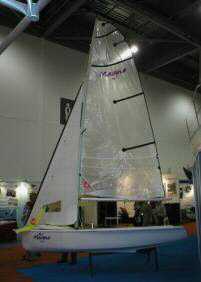
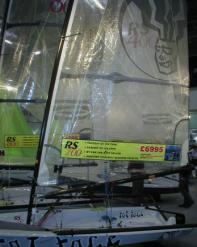
The aim of this part of the project was to have a detailed look at how current dinghies are fixing additions to the boat like rudders, masts and frames. Some detailed photos were taken to highlight these areas.
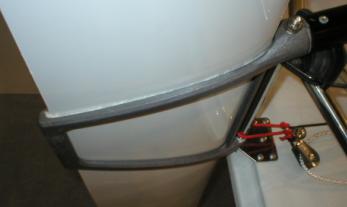 Photo
2 shows how
Photo
2 shows how
The rudder is attached on
an RS series boat.
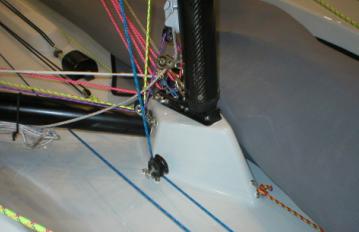 Photo
3. The mast attachment. A large amount of force is applied to the base of the
mast and therefore additional strength is required.
Photo
3. The mast attachment. A large amount of force is applied to the base of the
mast and therefore additional strength is required.
 Photo
4. The bracket that holds the cross beam on a catamaran is relatively small,
on a hydrofoil boat it will have to be able to withstand much higher forces,
therefore alternative designs will have to be considered.
Photo
4. The bracket that holds the cross beam on a catamaran is relatively small,
on a hydrofoil boat it will have to be able to withstand much higher forces,
therefore alternative designs will have to be considered.Many thanks to everyone we spoke to at the Boat Show, a lot of information was gathered about sails, and their relative advantages and disadvantages.
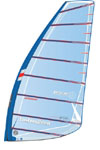 Tushingham
Sails were very helpful, and offered support for the project. We hope to be
in contact shortly about a potential sail that can be used in conjunction with
the foiling boat.
Tushingham
Sails were very helpful, and offered support for the project. We hope to be
in contact shortly about a potential sail that can be used in conjunction with
the foiling boat.

![]()
http://www.neilprydesails.com/productframe.htm Naish
Windsurfing were very friendly and despite missing out on speaking to Robby
Naish himself were still able to offer some support.
Naish
Windsurfing were very friendly and despite missing out on speaking to Robby
Naish himself were still able to offer some support.
© Future Foils 2003